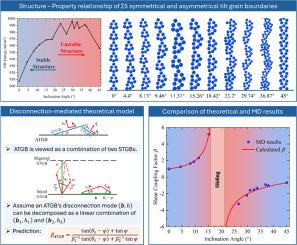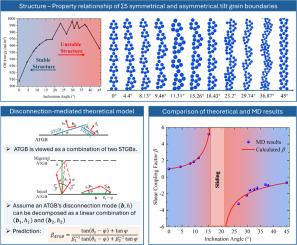Predicting shear coupling behaviors in disconnection-mediated migration of asymmetrical tilt grain boundaries
IF 12.8
1区 材料科学
Q1 ENGINEERING, MECHANICAL
引用次数: 0
Abstract
Grain boundaries (GBs) play a critical role in determining the mechanical properties of polycrystalline materials. Due to their inherent structural complexity and atomic variability, characterizing the loading response of GBs can be highly challenging. Disconnections, a type of line defects at GBs, have been widely used to model the migration of GBs under shear and has been extensively validated through experiments. While this approach has proven effective for symmetrical tilt grain boundaries (STGBs), it has encountered challenges when modeling asymmetrical tilt grain boundaries (ATGBs). Here, we combine molecular dynamics (MD) simulations with a disconnection-based theoretical model to investigate disconnection-mediated migration of ATGBs in Cu. Our model, which treats an ATGB under shear as a combination of two STGBs, yields predictions in excellent agreement with results from MD simulations for cases undergoing solely disconnection-mediated migration. We further discuss the adaptability of our model across various GB types and temperatures, covering more complex migration mechanisms. This study enhances our understanding of shear-coupled migration of ATGBs and offers potentially useful insights for GB engineering.


预测不对称倾斜晶界断连介导迁移中的剪切耦合行为
晶界对多晶材料的力学性能起着至关重要的作用。由于其固有的结构复杂性和原子可变性,表征gb的负载响应是非常具有挑战性的。断裂是一种线型缺陷,已被广泛用于模拟剪切作用下的gb迁移,并已通过实验得到了广泛的验证。虽然这种方法已被证明对对称倾斜晶界(stgb)是有效的,但它在建模不对称倾斜晶界(atgb)时遇到了挑战。在这里,我们结合分子动力学(MD)模拟和基于断开的理论模型来研究断开介导的atgb在Cu中的迁移。我们的模型将剪切下的ATGB视为两个stgb的组合,其预测结果与仅经历断开介导迁移的病例的MD模拟结果非常一致。我们进一步讨论了模型在各种GB类型和温度下的适应性,涵盖了更复杂的迁移机制。该研究增强了我们对atgb剪切耦合迁移的理解,并为GB工程提供了潜在的有用见解。
本文章由计算机程序翻译,如有差异,请以英文原文为准。
求助全文
约1分钟内获得全文
求助全文
来源期刊

International Journal of Plasticity
工程技术-材料科学:综合
CiteScore
15.30
自引率
26.50%
发文量
256
审稿时长
46 days
期刊介绍:
International Journal of Plasticity aims to present original research encompassing all facets of plastic deformation, damage, and fracture behavior in both isotropic and anisotropic solids. This includes exploring the thermodynamics of plasticity and fracture, continuum theory, and macroscopic as well as microscopic phenomena.
Topics of interest span the plastic behavior of single crystals and polycrystalline metals, ceramics, rocks, soils, composites, nanocrystalline and microelectronics materials, shape memory alloys, ferroelectric ceramics, thin films, and polymers. Additionally, the journal covers plasticity aspects of failure and fracture mechanics. Contributions involving significant experimental, numerical, or theoretical advancements that enhance the understanding of the plastic behavior of solids are particularly valued. Papers addressing the modeling of finite nonlinear elastic deformation, bearing similarities to the modeling of plastic deformation, are also welcomed.
 求助内容:
求助内容: 应助结果提醒方式:
应助结果提醒方式:


